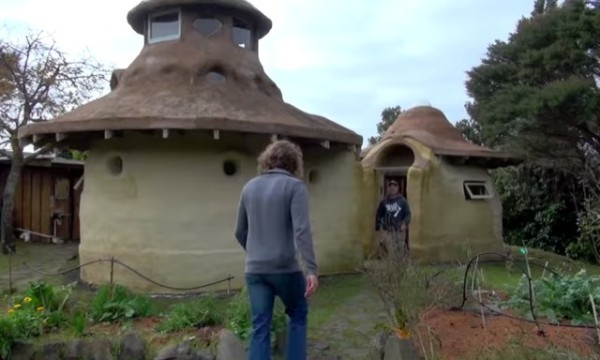The tiny house trend will most likely increase over the coming years as people seek to reduce expenditures, debt and carbon footprints. The move toward living a more simple and self-sufficient life is one that will provide opportunities for developing greater connections with nature and allow communities to re-group
Earthbag building is a relatively inexpensive method of construction which can be built quickly and cost effectively. It uses natural materials (usually local), generally requiring sturdy sacks which are filled with inorganic material. Subsoil that contains enough clay to become cohesive when tamped, gravel, sand or volcanic rock are common materials used for earthbag building. Walls are built by laying bags or tubing on top of each other, similar to brick laying. Walls can be straight, curved or dome shaped similar to the one in the video clip below.
Construction generally begins by digging a trench to the subsoil which can then be partially filled with cobble stones or gravel to create a foundation which helps prevent moisture wicking from the Earth. Inside the trench, bags or tubes filled with gravel can be placed which provide a water-resistant foundation. Bags vary in construction based on site requirements. Popular bags include Polypropylene (the ones used to transport for rice and other grains) which are inexpensive and resistance to water damage, rot and insects. More natural fibre bags can be used such as hemp and burlap, however these need to be filled with materials that are high in clay content to avoid rotting.
When building the walls, bags or tubing are simply placed on top of the previous bags or tubes. To ensure there is no slippage, barbed wire or other similar materials can be used to help maintain the walls integrity. The wire digs into the bags and prevents any possible slippage of subsequent layers. To form a roof, bags are gradually slopped toward the center to form a dome like construction. Alternatively, traditional building materials like wooden beams or other conventional roofing materials can be used. When the structure is complete the walls can be rendered with either cement-based stucco, or lime or earthen plaster.
Solscape is a working Eco retreat in New Zealand dedicated to creating models of sustainable living. The retreat provides some great examples of what can be done with earth dome construction. Solscape also has some great examples of other alternative accommodation from tipi’s to cabooses, earth domes to high end eco design lodgings.












Sign up on lukeunfiltered.com or to check out our store on thebestpoliticalshirts.com.